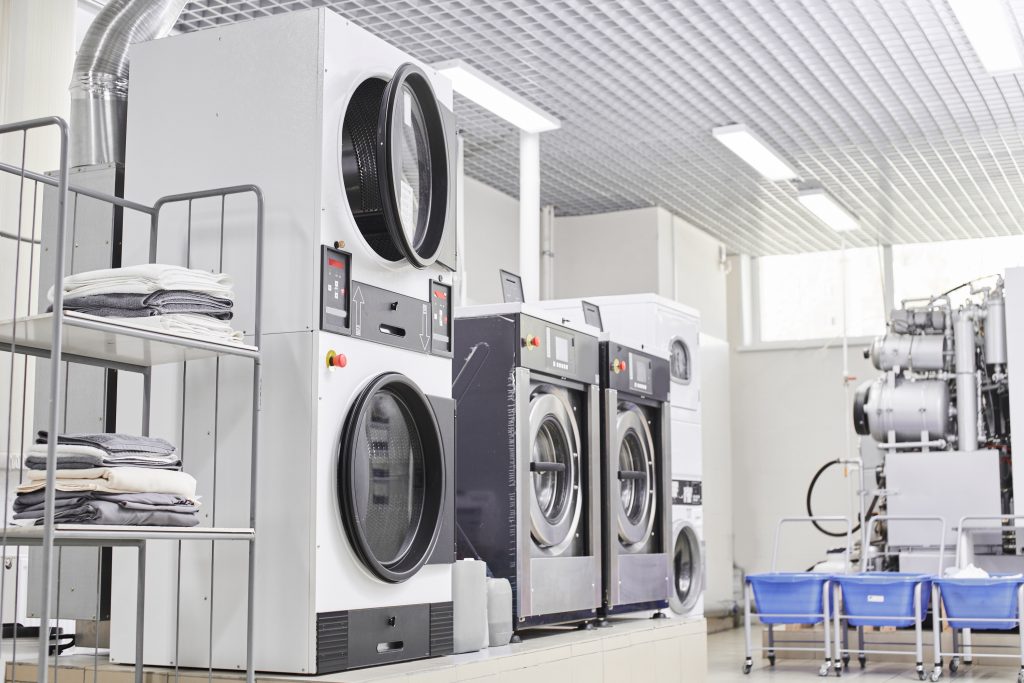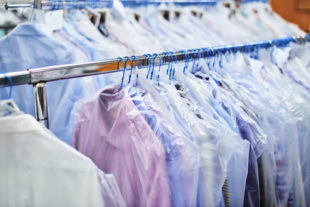 Get Garment Guides
Get Garment Guides
8 Reasons To Use A Fast Turnaround Dry Cleaners
👗New Service Alert – Quinceanera Dress Preservation!
Read tips, tricks, and how-to’s on our Fabric of Life blog.
Garment Guides

A dry cleaner utilizes organic solvents to clean clothes more gently and effectively. Rather than washing with water in a washing machine, dry cleaning uses methods to maintain the quality of your fabrics, extend the lifespan, and remove stubborn stains.
Dry cleaning describes a professional cleaning process that involves the use of minimal water and special solvents to ensure a deep clean on all clothes and garments. Rather than washing with water in a washing machine, dry cleaning uses methods that maintain the quality of your fabrics, extend the lifespan, and remove stubborn stains.
Instead of using water, a dry cleaner utilizes organic solvents to clean clothes more gently and effectively. Unlike regular washing machines, special solvents and expert techniques can be a safer solution for even the most delicate of fabrics. So, how exactly does the dry cleaning process work?
There are three stages to the dry-cleaning process. Let’s take a look at each of these three stages and their role in maintaining the quality and appearance of all clothes and fabrics.
The initial stage of dry cleaning is the dry scouring and pre-treatment phase. Dry scouring is a technique used to remove stubborn stains without the use of water. Instead of tossing garments into a washing machine, a dry cleaner will use a variety of solvents to remove dirt and treat stains without causing any shrinkage or damage to the clothes. With the pre-treatment stage, dry cleaning services can ensure each garment is returned to its owner in its top condition.
The second stage is the cleaning cycle in a dry-cleaning machine. It is important to note that dry cleaning machines differ from the typical washing machines you find in homes and laundromats. In these machines, organic solvents are used instead of water. These solvents dissolve oil-based stains and grime while being gentle on fabrics. This cleaning cycle also does not submerge the garments, minimizing wear and tear, making it ideal for delicate fabrics.
The final stage comes once the cleaning cycle has concluded. Once clean, garments enter the drying phase which uses warm air to remove excess solvents. During the drying stage, professional dry cleaners will also complete a thorough inspection of each textile, ensuring they are stain-free and ready to be returned to the client. In some cases, pressing or ironing may be used to finish off the dry-cleaning process.
At the most basic level, dry cleaning is a method of “washing” clothes where the water usually used in the cleaning process is replaced with a solvent. Water is removed from the process to allow for the cleaning of garments that might be damaged, distorted, or otherwise harmed if they come into contact with water. While there are several different solvent options that can be used during dry cleaning, the most widely used is perchloroethylene (perc), but liquid carbon dioxide and synthetic petroleum hydrocarbon solvent are commonly used.
The solvent used is typically up to the direction and expertise of the dry cleaner. However, each of these three solvents has its own benefits and uses. Up to 85% of U.S. dry cleaners use perchloroethylene as it is highly effective and affordable, but there are also many risks associated with perc which is why CD One Price Cleaners doesn’t use perc in any of its stores. In fact, on December 9th 2024, the EPA banned PERC and begun planning a 10 year phaseout.
Liquid carbon dioxide is also an inexpensive, yet highly effective solvent. Hydrocarbon solvent—used by about 20% of cleaners—is an effective dry-cleaning solvent that cleans similarly to perc but is engineered to mitigate some of the risks associated with perc.
So, we know how dry cleaning works but what are the actual benefits of a traditional washing opportunity? Here are a few key benefits of dry cleaning your clothes:
Many individuals prefer dry cleaning over the use of a washing machine because of its ability to lengthen the life expectancy of their favorite garments. Dry cleaning is especially effective at preserving delicate fabrics and natural fibers, which are more vulnerable to damage during traditional washing. For example, clothing items made from natural or fragile fibers, such as silk, wool, and lace, require gentle care. Unlike standard washing machines, which can lead to issues like shrinkage, fading, and fabric weakening, the dry-cleaning process helps protect these items and keeps them looking new longer.
Many garments cannot just simply be thrown into the washing machine. If you take a look at some of your most delicate fabrics, you may notice that the care label advises handwashing or dry cleaning. This is because, as we mentioned, a standard washing machine is not gentle enough to prevent damage from occurring. Instead, a dry cleaner can use their expertise and gentle solutions to effectively clean, dry, and press all delicate and specialty fabrics.
Many people bring their clothes to dry cleaners because dry cleaning is a highly effective way to remove even the most stubborn stains. Not only do these cleaners use specialized chemicals to remove these stains, but they also take great precautions to ensure there is no harm to the fabric. This means that even with the toughest stains, a dry-cleaning experience can provide a reliable and safe way to clean your clothes.
Nowadays a lot of cleaning businesses are shifting towards environmentally friendly options by steering clear of harsh chemicals and opting for greener solutions instead. The eco-friendly techniques employ cleaning products that effectively remove stains while being safer, for both your wellbeing and the ecosystem.
Another benefit of dry cleaning is its impact on maintaining the overall vibrancy of colors and brightness of white garments. Overtime, yellowing and fading can occur which is why regular dry cleaning is important. With consistent trips to the dry cleaners, you can prevent fading and yellow stains from occurring. The act of regular dry cleaner also keeps garments and fabrics in pristine condition by reducing staining and grime build-up.
A regular dry-cleaning routine is particularly helpful for garments that require consistent upkeep, such as business attire or special occasion clothing. By having your clothes cleaned professionally, you ensure they stay free from buildup, maintain their shape, and look fresh longer. Routine dry cleaning also helps fabrics maintain their softness and luster, giving you confidence in your clothes’ longevity and quality.
Regular dry cleaning can greatly protect the integrity of your wardrobe. However, to ensure you maintain the quality in between cleanings, follow these additional steps:
By following these proactive steps, you can keep your clothing in tip-top shape, even in between dry-cleaning sessions. These tips not only ensure your clothes are safe from wrinkles, stains, and damage, but they also ensure longevity, allowing you to keep your favorite items for longer.
The truth is that not every dry-cleaning service is created equally. To ensure your clothes are receiving the very best care, consider the following when choosing your dry-cleaning professional:
When deciding which dry cleaner to take your clothes to, it is important to consider the quality of the customer service. A professional dry cleaner will offer supreme garment care as well as responsive customer service. Your chosen cleaner should be able to answer all your questions, provide accurate time quotes, and ensure a positive dry-cleaning experience. These factors play a tremendous role in overall customer satisfaction, which can be a deciding factor for many to go back or find a new cleaner.
The decision of which dry cleaner is best for your clothes will also be determined by how reliable their equipment and treatments are. A good dry cleaning facility will have a well-maintain dry cleaning machine that works gently and consistently to cleanse clothes. By choosing a dry cleaning establishment that complies with all industry standards and stay up-to-date with innovative treats, you can rest assured your clothes are in the hands of a trusted professional.
Are you in the Chicago, St. Louis, or Minneapolis area? CD One Price Cleaners is a top dry cleaning experience known for professional garment care and expert knowledge of the needs of special fabrics. Our team at CD One Price Cleaners can handle everything from everyday clothes to delicate specialty fabrics, providing tender care for each item.
For anyone seeking regular, professional dry cleaning on a regular basis, CD One Price Cleaners is a smart, budget-friendly choice. Visit CD One Price Cleaners today and learn more about our comprehensive dry-cleaning services!
We think you may like
 Get Garment Guides
Get Garment Guides
8 Reasons To Use A Fast Turnaround Dry Cleaners
 Get Garment Guides
Get Garment Guides
Behind the Scenes of a Dry Cleaner
 Get Tips and Tricks
Get Tips and Tricks
Tips on Choosing Your Dry Cleaners